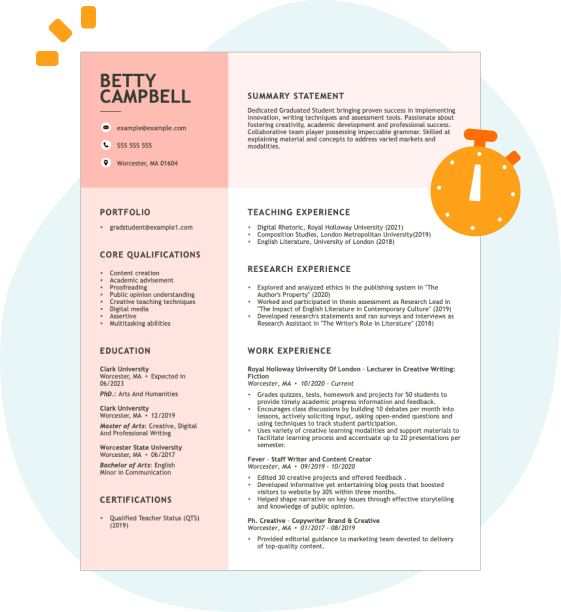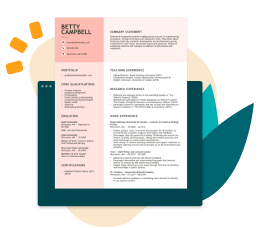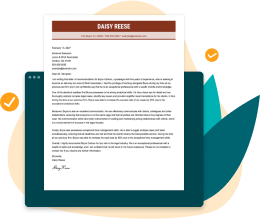Hard skills are technical abilities such as engine diagnostics, repair techniques, and knowledge of automotive systems that a mechanic must master.
Popular Mechanic Resume Examples
Check out our top mechanic resume examples that emphasize key skills such as diagnostics, repair techniques, and customer service. These examples illustrate how to effectively showcase your qualifications and experiences in the automotive field.
Ready to build your own impressive resume? Our Resume Builder offers user-friendly templates specifically designed for mechanics, helping you to highlight your expertise with ease.
Entry-level mechanic resume
This entry-level resume for a mechanic effectively showcases the job seeker's extensive hands-on experience. It emphasizes their skill in diagnostics and repair, demonstrated through significant achievements at previous employers. New professionals in this field must illustrate their technical skills and commitment to service excellence to ensure they stand out even with limited work history.
Mid-career mechanic resume
This resume skillfully showcases qualifications by emphasizing hands-on experience and leadership roles. The clear articulation of achievements and certifications illustrates the job seeker's readiness for advanced responsibilities, reflecting a strong career trajectory in automotive repair.
Experienced mechanic resume
The work history section demonstrates the applicant's robust experience as a mechanic, highlighting their achievements in increasing service efficiency by 15% and servicing over 300 vehicles annually. The clear formatting allows hiring managers to easily identify key accomplishments at a glance.
Resume Template—Easy to Copy & Paste
Aiko Liu
Cedar Valley, MN 55134
(555)555-5555
Aiko.Liu@example.com
Skills
- Engine Diagnostics
- Advanced Electrical Systems
- Customer Service Excellence
- Vehicle Performance Optimization
- Precision Troubleshooting
- Inventory Management
- Quality Assurance
- Problem Solving Leadership
Languages
- Spanish - Beginner (A1)
- German - Intermediate (B1)
- French - Beginner (A1)
Professional Summary
Detail-oriented Mechanic with a proven track record of optimizing vehicle performance and enhancing operational efficiency. Expert in precision diagnostics and cost-effective solutions, dedicated to achieving high customer satisfaction.
Work History
Mechanic
Precision Auto Care - Cedar Valley, MN
January 2024 - November 2025
- Enhanced efficiency in repairs by 30%
- Reduced customer complaint rate by 40%
- Implemented cost-saving techniques saving 20K
Automobile Technician
Advanced Motors Workshop - Cedar Valley, MN
February 2021 - December 2023
- Diagnosed mechanical issues reducing downtime
- Serviced over 100 vehicles monthly
- Improved safety standards by 25%
Vehicle Maintenance Specialist
AutoPro Service Center - Minneapolis, MN
January 2019 - February 2021
- Streamlined inventory management cutting costs 15%
- Led a team improving service efficiency 20%
- Achieved record customer satisfaction in 2020
Certifications
- Automotive Service Excellence (ASE) Certification - National Institute for Automotive Service Excellence
- Certified Mechanical Expert - Auto Mechanics Guild
Education
Bachelor of Science Mechanical Engineering
University of Illinois Champaign, IL
May 2018
Associate Degree Automotive Technology
Lincoln Technical Institute Melrose Park, IL
May 2014
How to Write a Mechanic Resume Summary
Your resume summary is the first thing employers will notice, so it's important to make it effective. As a mechanic, you should highlight your technical skills, problem-solving abilities, and relevant certifications to capture attention right away. The following examples will illustrate effective approaches that can help you craft a compelling summary that stands out:
Weak resume summary
I am a skilled mechanic with several years of experience. I hope to find a job where I can use my skills and contribute positively to the workplace. A supportive environment with chances for advancement is what I seek. I believe I can be a great asset if given the chance.
- Contains vague phrases about experience that do not highlight specific skills or accomplishments
- Relies heavily on personal aspirations rather than detailing what unique value the job seeker brings to potential employers
- Uses generic language that fails to differentiate the applicant from others in the field, making it less compelling
Strong resume summary
Detail-oriented mechanic with 7 years of experience in automotive repair and maintenance, specializing in engine diagnostics and transmission services. Increased customer satisfaction ratings by 20% through effective communication and timely service delivery. Proficient in using diagnostic tools, performing complex repairs, and adhering to safety regulations.
- Begins with clear years of experience and specific areas of expertise
- Highlights a quantifiable achievement that shows improved customer service outcomes
- Showcases relevant technical skills essential for mechanics, improving appeal to potential employers
PRO TIP
Showcasing Your Work Experience
The work experience section is important for your resume as a mechanic, where you'll provide the bulk of your content. Good resume templates always emphasize this section to highlight your practical skills and experiences.
This part should be laid out in reverse-chronological order, detailing your previous jobs. Use bullet points to succinctly describe achievements and specific tasks handled in each role.
To illustrate what constitutes an effective work history section, we'll present some examples that clarify what works well and what doesn’t.
Mechanic
Auto Repair Shop – Los Angeles, CA
- Fixed cars and trucks
- Performed oil changes and tire rotations
- Assisted customers with their vehicle issues
- Kept the garage clean and organized
- Lacks specific dates of employment
- Bullet points do not highlight any technical skills or certifications
- Focuses on basic tasks rather than demonstrating problem-solving or efficiency improvements
Mechanic
Precision Auto Repair – Seattle, WA
March 2020 - Current
- Diagnosed and repaired vehicle issues for over 300 customers annually, achieving a 95% customer satisfaction rating
- Implemented a new inventory management system that reduced parts ordering time by 30%, improving operational efficiency
- Trained junior mechanics on advanced diagnostic techniques, contributing to a 20% reduction in repair turnaround times
- Starts each bullet point with dynamic action verbs that highlight the job seeker's contributions
- Incorporates specific metrics to illustrate the impact of the mechanic’s work
- Demonstrates relevant technical skills while showcasing improvements made within the role
While your resume summary and work experience are important, other sections also play a significant role in showcasing your skills. Each part deserves careful attention to create a well-rounded impression. For more detailed advice, visit our complete guide on how to write a resume.
Top Skills to Include on Your Resume
A well-defined skills section is important for your mechanic resume, as it allows you to showcase your qualifications and expertise at a glance. This helps potential employers quickly identify if you have the necessary abilities for the job.
For mechanics, highlight both technical skills and soft skills. Focus on competencies such as engine repair, diagnostics using tools like OBD-II scanners, and familiarity with software systems used in modern vehicles, while also emphasizing problem-solving and communication abilities to work effectively with clients and team members.
Soft skills include problem-solving, communication, and teamwork, which are essential for effectively collaborating with colleagues and providing excellent service to customers.
When selecting resume skills for your resume, it’s important to align them with what employers expect from applicants. This alignment not only improves your appeal but also helps you pass through automated screening systems that filter out unqualified applicants.
To effectively choose the right skills, carefully review job postings related to your desired position. They often highlight the key competencies sought by recruiters and can guide you in emphasizing those skills on your resume.
PRO TIP
10 skills that appear on successful mechanic resumes
Improving your resume with sought-after skills is important for attracting the attention of hiring managers in the mechanic field. You can see these skills in our resume examples, allowing you to present yourself confidently as a qualified job seeker.
Here are 10 essential skills you should consider adding to your resume if they align with your experience and job requirements:
Diagnostic troubleshooting
Attention to detail
Mechanical aptitude
Problem-solving abilities
Customer service skills
Time management
Knowledge of automotive systems
Ability to work under pressure
Team collaboration
Safety compliance
Based on analysis of 5,000+ mechanics professional resumes from 2023-2024
Resume Format Examples
Choosing the right resume format is important for mechanics as it showcases essential skills, relevant experience, and career advancements in a clear and compelling manner.
Functional
Focuses on skills rather than previous jobs
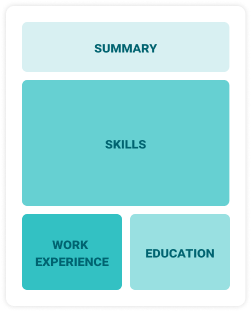
Best for:
Recent graduates and career changers with limited experience in mechanics
Combination
Balances skills and work history equally
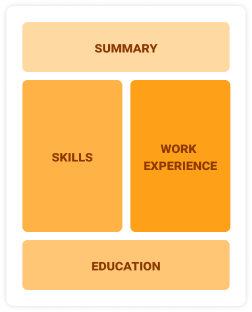
Best for:
Mid-career professionals seeking to highlight their skills and growth potential
Chronological
Emphasizes work history in reverse order

Best for:
Experienced mechanics excelling in advanced diagnostics and team leadership
Mechanic Salaries in the Highest-Paid States
Our mechanic salary data is based on figures from the U.S. Bureau of Labor Statistics (BLS), the authoritative source for employment trends and wage information nationwide.
Whether you're entering the workforce or considering a move to a new city or state, this data can help you gauge what fair compensation looks like for mechanics in your desired area.
Frequently Asked Questions
Should I include a cover letter with my mechanic resume?
Absolutely. Including a cover letter is a great way to showcase your skills and enthusiasm for the mechanic position. It allows you to personalize your application and highlight relevant experience that may not be evident in your resume. If you're looking for guidance, check out our template on how to write a cover letter or use our Cover Letter Generator to create one tailored to your needs.
Can I use a resume if I’m applying internationally, or do I need a CV?
When applying for jobs outside the U.S., a CV is often preferred over a resume. A CV provides a comprehensive overview of your career, education, and skills. For assistance with how to write a CV, explore our detailed guides and examples tailored to meet international standards. Additionally, you can find various CV examples that illustrate effective formatting and content strategies.
What soft skills are important for mechanics?
Interpersonal skills, communication, problem-solving, and teamwork are essential for mechanics. These skills foster better interactions with customers and colleagues, ensuring clear explanations of repairs and improving collaboration in a workshop setting.
I’m transitioning from another field. How should I highlight my experience?
When applying for mechanic roles, highlight your transferable skills like attention to detail, teamwork, and critical thinking. These attributes showcase your ability to learn quickly and adapt, even without direct experience in the field. Use examples from past jobs to demonstrate how you've successfully tackled challenges related to vehicle maintenance or repair tasks.
Should I use a cover letter template?
Yes, using a cover letter template tailored for mechanics can significantly improve your application by providing a structured format that showcases relevant skills, such as diagnostic abilities and hands-on experience with various vehicle systems, capturing the attention of hiring managers effectively.
Should I include a personal mission statement on my mechanic resume?
Including a personal mission statement in your resume is highly recommended. This addition effectively conveys your values and career aspirations, particularly for roles within organizations that emphasize teamwork and innovation. When you incorporate this approach, it aligns well with companies that have a clear vision or ethical foundation.


